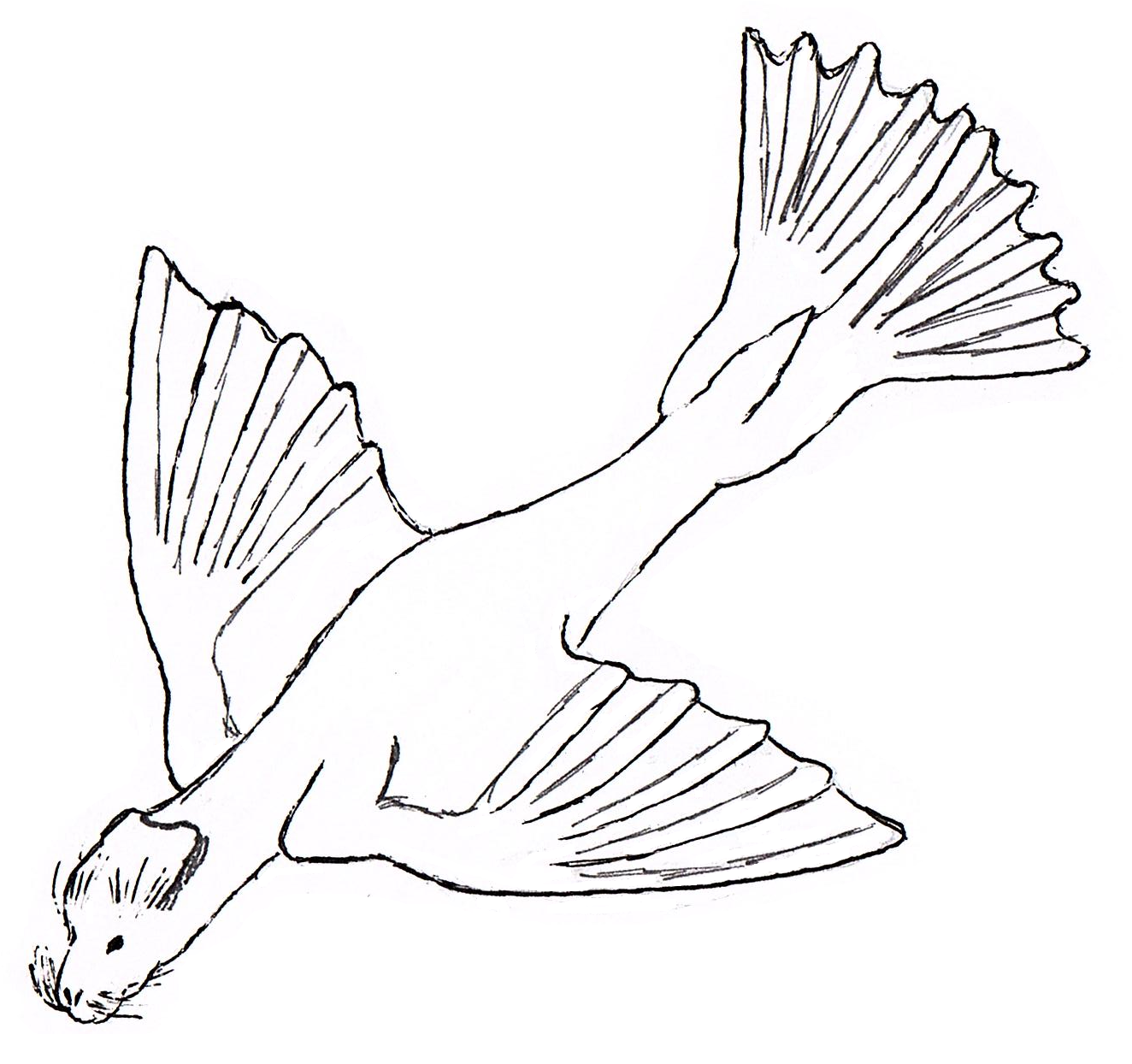tkevsa (/'tkɛv.sʌ/)
Tkevsa are a sapient species inhabiting Tokled, a chain of volcanic islands recently discovered in the Vast Eastern Gap.
Basic Information
Anatomy
Of the sapient species living on Ocean islands, tkevsa are by far the oddest in appearance. They are quadrupedal, with low-slung bodies that rest on the ground when the they are not moving. Their forelimbs appear quite short, with broad and thin flippers. The hind limbs are similar, except that the toes are far more dextrous. The webbing between them is looser than in the forelimbs, allowing them greater range of independent motion. The hair on the margins of the webbing is the longest on a tkevsa's body, and is used to sense objects and surfaces that the tkevsa is facing the wrong way to see.
Locomotion
On land, tkevsa travel in a bounding motion--they move their forequarters and hindquarters alternately, rather like a measuring worm. At high speeds they will become briefly airborne, flattening the trunk and spreading the forelimbs. In this shape a tkevsa resembles a delta wing, which is the key to the species' remarkable flying ability. While no tkevsa is capable of powered flight, by maneuvering their fins in midair they can glide for hours in optimal wind conditions.Dietary Needs and Habits
The tkevsa diet consists primarily of birds and eggs for protein, supplemented by fruits to provide necessary vitamins.
Additional Information
Geographic Origin and Distribution
Tkevsa populations currently exist on only three of the five islands in the archipelago. More than 75% are found on the largest island, and are further distributed in three main groups: West-Cliff tkevsa, who live on the steep lee side of the volcano's peak; Mountain-Shadow tkevsa, claiming the northeast slope and territory from there to the ocean; and Coastal-Plains tkevsa, occupying the broader low-lying areas from the foot of the mountain to the southeast arc of shore.
Perception and Sensory Capabilities
Tkevsa are typically farsighted and have keen eyes and noses, but far more impressive are the ranks of whiskers on their heads and hind feet. Before taking flight, tkevsa will point their faces to the sky to sense the direction and strength of the wind using their facial whiskers.
In addition, they have a hydrotropism-based sense that allows them to predict near-future occurrences. They are able to modify their planned actions based on that knowledge, which makes them appear--to non-tkevsa intellegences--to be in the habit of taking ridiculous chances that always seem to come out right.
Civilization and Culture
Naming Traditions
Tkevsa are not given names. During childhood, they are referred to by various epithets appropriate to the situation. Once they reach physical maturity, a tkevsa chooses a name for themself with a specific pronunciation that no one else may duplicate exactly. When meeting a stranger, a tkevsa offers first their personal name, then an approximation that may be used by others. It is considered an insult to address a named tkevsa vocally by an epithet. A tkevsa may also acquire a written name, if they gain a strong reputation. Examples are Lifebringer and Peacemaker. Otherwise, a tkevsa is referred to in writing by their occupation.
Major Language Groups and Dialects
Tkevsa have a repertoire of calls, but no proper spoken language. Vocally, they can give warnings, insult one another, and issue simple commands. At close range, they communicate primarily through a written language, which they write using their toes and read via the sensitive hairs on their feet. Tkevsa also employ a sign language, used at large distances or when communicating with large groups.
As the example of Trivyu the Peacemaker shows, a tkevsa that has spent its infancy and childhood around chatty humans can grow up to speak limited Oceantongue.
Common Myths and Legends
Tkevsa revere the islands and fear the ocean. They believe their ancestors angered the sea and that the land rose out of the water to save them from destruction.
Conservation Status
Because of their perceived adversarial relationship with the ocean, tkevsa consider themselves endangered. Since they live only on a single tiny archipelago, that's not an unreasonable opinion. Their survival as a species depends on their ability to glide from old islands to new ones, and they have gone through several bottleneck situations when as much as 80% of a migrating population did not survive the trip.
Geographic Distribution
Related Myths
Related Technologies
Remove these ads. Join the Worldbuilders Guild



Comments